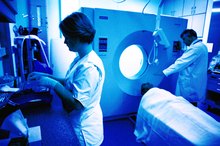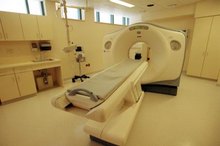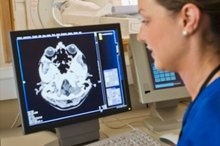Side Effects of MRI With Contrast
**Magnetic resonance imaging (MRI) is a method of scanning the body that provides clear, detailed pictures of organs and tissues 6.
** A contrast dye is sometimes injected into a vein during an MRI scan to improve the ability to see certain structures. All dyes used for MRIs contain a metal called gadolinium, which is attached to another molecule that varies from dye to dye.
These dyes — called gadolinium-based contrast agents (GBCAs) — have been used for nearly 30 years, with over 300 million doses being given throughout the world, according to a review article in the December 2016 issue of “Magnetic Resonance Imaging.” They are generally very safe, but side effects are possible 6.
Most Common Side Effects
According to a report published by the American College of Radiology (ACR) in 2017, side effects occur in between 0.07 and 2.4 percent of MRIs with contrast 4. Most of these side effects are mild and temporary.
Some GBCAs temporarily interfere with blood tests for calcium, causing calcium levels to appear falsely low. The actual amount of calcium in the blood is not affected. Some GBCAs may also transiently interfere with blood tests for iron, copper and zinc.
- According to a report published by the American College of Radiology (ACR).
- Some GBCAs temporarily interfere with blood tests for calcium, causing calcium levels to appear falsely low.
Allergic Reactions
Why Is Creatine Level Important for a Brain MRI?
Learn More
Allergic reactions with GBCAs are rare. The 2017 ACR report noted that allergic reactions occur in 0.004 to 0.7 percent of GBCA injections.
Most allergic reactions are mild, producing hives, other rashes, itchiness, a stuffy nose or sneezing. Facial swelling or wheezing may occur with more serious reactions.
Anaphylaxis — a severe, life-threatening allergic reaction — is very rare, occurring in 0.001 to 0.01 percent of GBCA injections, according to the 2017 ACR report. Allergic reactions occur shortly after a GBCA is injected and are usually easily treated with appropriate medications.
The risk of an allergic reaction may be slightly higher in people with asthma or other types of allergic diseases. They are more common in women than men.
People with an allergic reaction to a GBCA have a 30 percent chance of a reaction when given a GBCA in the future, according to a study reported in the August 2012 issue of “Radiology. ”
For individuals with a previous reaction, the radiologist may avoid all GBCAs or may choose a different GBCA and administer a steroid medication beforehand to reduce the likelihood of a reaction.
- Allergic reactions with GBCAs are rare.
- Anaphylaxis — a severe, life-threatening allergic reaction — is very rare, occurring in 0.001 to 0.01 percent of GBCA injections, according to the 2017 ACR report.
Nephrogenic Systemic Fibrosis
Nephrogenic systemic fibrosis (NSF) occasionally occurs in people with severe kidney disease who receive a GBCA. In this disorder, fibrous tissue — firm scar-like tissue — develops in many parts of the body.
NSF occurs when GBCAs accumulate in the body because kidney disease limits their removal through the urine. Gadolinium collects in tissues and organs, where it triggers the formation of fibrous tissue.
The risk of developing NSF is much higher with some types of GBCAs than others. If an MRI with contrast is considered necessary in a person with poor kidney function, the radiologist will likely choose one of the low-risk GBCAs, as explained in the 2017 ACR report.
- Nephrogenic systemic fibrosis (NSF) occasionally occurs in people with severe kidney disease who receive a GBCA.
- If an MRI with contrast is considered necessary in a person with poor kidney function, the radiologist will likely choose one of the low-risk GBCAs, as explained in the 2017 ACR report.
Brain Deposits
Allergic Reaction to Barium Sulfate
Learn More
On July 27, 2015, the US Food and Drug Administration (FDA) announced that recent research showed small amounts of gadolinium remaining in the brain of some people for a long time — months to years — after receiving GBCAs 1. This primarily occurred in people receiving at least 4 MRIs with contrast and was observed even in people with normal kidney function.
In an update on December 19, 2017, the FDA announced that although gadolinium collections can occur, there is no good scientific evidence that they produce any harmful effects in people with normal kidneys. However, it did state that drug labels for all GBCAs must contain a warning that gadolinium can accumulate in the body 3.
A review article published in the May 2017 issue of “Advances in Chronic Kidney Disease” confirmed that gadolinium may accumulate in the brain, but there is currently no scientific evidence that these deposits are harmful in humans 8. Additional research is necessary to help clarify this issue.
- On July 27, 2015, the US Food and Drug Administration (FDA).
- In an update on December 19, 2017, the FDA.
Other Potential Side Effects
GBCAs can occasionally cause sudden worsening of kidney function in people with pre-existing kidney disease. This may be more common with higher doses of GBCAs, so the FDA-approved drug labels for all GBCAs recommend using the lowest dose that gives adequate MRI results.
Gadolinium may accumulate in other parts of the body besides the brain in people with normal kidney function.
The term gadolinium deposition disease (GDD) has been used by some experts to describe a collection of symptoms developing after MRIs with contrast in people without kidney disease. The symptoms include headaches, bone or joint pain and skin thickening, among others.
As explained in the May 2017 review article in “Advances in Chronic Kidney Disease,” GDD is similar in some ways to NSF and may represent a mild form of that disease 8.
But not all experts agree that GDD is an actual disorder, and the December 2017 FDA update indicated that NSF is the only disease definitely caused by GBCA use. More research is needed to resolve this controversy.
- GBCAs can occasionally cause sudden worsening of kidney function in people with pre-existing kidney disease.
- The term gadolinium deposition disease (GDD) has been used by some experts to describe a collection of symptoms developing after MRIs with contrast in people without kidney disease.
Related Articles
References
- U.S. Food and Drug Administration: Questions and Answers on Gadolinium-Based Contrast Agents
- U.S. Food and Drug Administration: FDA Drug Safety Communication -- FDA Evaluating the Risk of Brain Deposits With Repeated Use of Gadolinium-based Contrast Agents for Magnetic Resonance Imaging (MRI)
- U.S. Food and Drug Administration: FDA Drug Safety Communication -- FDA Warns That Gadolinium-based Contrast Agents (GBCAs) Are Retained in the Body; Requires New Class Warnings
- American College of Radiology: ACR Manual on Contrast Media, Version 10.3
- Radiology: Immediate Hypersensitivity Reaction to Gadolinium-based MR Contrast Media
- Magnetic Resonance Imaging: Gadolinium Toxicity and Treatment
- National Institutes of Health, DailyMed: Optimark- gadoversetamide injection, solution
- Advances in Chronic Kidney Disease: Gadolinium Retention and Toxicity -- An Update
- National Institutes of Health, DailyMed: Gadavist -- Gadobutrol Injection
- Ibrahim MA, Gupta N, Dublin AB. Magnetic resonance imaging (MRI) gadolinium. In: StatsPearl. Updated January 12, 2020.
- Royal College of Radiologists. Guidance on gadolinium-based contrast administration to adult patients. April 2019.
- American College of Radiology. ACR Manual on Contrast Media (Volume 10.3). Updated 2020.
- Bauer K, Lathrum A, Raslan O, et al. Do gadolinium-based contrast agents affect F-FDG PET/CT uptake in the dentate nucleus and the globus pallidus? A pilot study. J Nucl Med Technol. 2017;45(1):30-3. doi:10.2967/jnmt.116.180844
- Lux J, Sherry AD. Advances in gadolinium-based MRI contrast agent designs for monitoring biological processes in vivo. Curr Opin Chem Biol. 2018;45:121-30. doi:10.1016/j.cbpa.2018.04.006
- U.S. Food and Drug Administration. FDA drug safety communication: FDA warns that gadolinium-based contrast agents (GBCAs) are retained in the body; requires new class warnings. Updated May 16, 2018.
- Granata V, Cascella M, Fusco R, et al. Immediate adverse reactions to gadolinium-based MR contrast media: A retrospective analysis on 10,608 examinations. Biomed Res Int. 2016;2016:3918292. doi:10.1155/2016/3918292
- Neeley C, Moritz M, Brown JJ, Zhou Y. Acute side effects of three commonly used gadolinium contrast agents in the paediatric population. Br J Radiol. 2016;89(1063):20160027. doi:10.1259/bjr.20160027
- Stoker J. MRI of the Gastrointestinal Tract (Medical Radiology) (2010 Ed). New York, NY: Springer; July 2010.
- Lungu E, Moser TP. A practical guide for performing arthrography under fluoroscopic or ultrasound guidance. Insights Imaging. 2015;6(6):601-10. doi:10.1007/s13244-015-0442-9
- Kaewlai R, Abujudeh H. Nephrogenic systemic fibrosis. AJR Am J Roentgenol. 2012;199(1):W17-23. doi:10.2214/AJR.11.8144
- Schieda N, Blaichman JI, Costa AF, et al. Gadolinium-based contrast agents in kidney disease: A comprehensive review and clinical practice guideline issued by the Canadian Association of Radiologists. Can J Kidney Health Dis. 2018;5:2054358118778573. doi:10.1177/2054358118778573
- Choi JW, Moon WJ. Gadolinium deposition in the train: Current updates. Korean J Radiol. 2019;20(1):134-47. doi:10.3348/kjr.2018.0356
- Gulani V, Calamante F, Shellock FG, Kanal E, Reeder SB. Gadolinium deposition in the brain: summary of evidence and recommendations. Lancer Neurol. 2017 Jul;16(7):564-70. doi:10.1016/S1474-4422(17)30158-8
- Wu SJ, Sylwestrzak G, Shah C, Devries A. Price transparency for MRIs increased use of less costly providers and triggered provider competition. Health Aff (Millwood). 2014;33(8):1391-8. doi:10.1377/hlthaff.2014.0168
- American College of Radiology. ACR-SPR practice parameter for the use of intravascular contrast media. Revised 2017.
- Reddy U, White MJ, Wilson SR. Anaesthesia for magnetic resonance imaging. Cont Edu Anaesthesia Crit Care Pain. 2012 Jun;12(3):140-4. doi10.1093/bjaceaccp/mks002
- American College of Obstetricians and Gynecologists. Guidelines for diagnostic imaging during pregnancy and lactation. Revised February 2016.
- Rosenkrantz AB. MRI interpretation volumes: Consideration of setting a bar. J Am Coll Radiol. 2020;17(2):312-3. doi:10.1016/j.jacr.2019.10.009
Writer Bio
Based in Houston, Texas, Dr. Mary D. Daley has been writing and editing health and medicine articles for more than 20 years. Daley holds an MD degree, as well as an MS in immunology and MS in biomedical writing. She is board-certified as an anesthesiologist in the United States and Canada.









